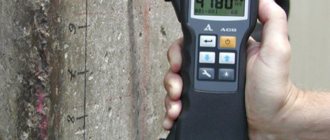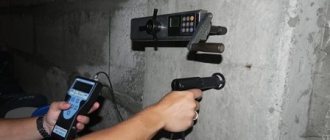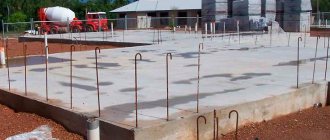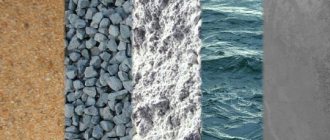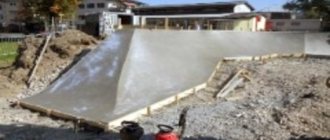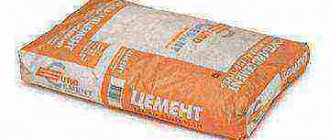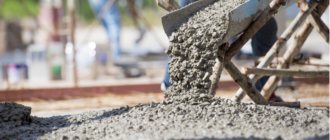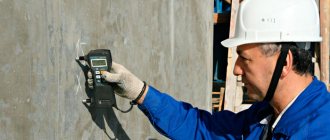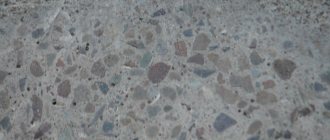Construction Materials.
GOST 17624-87 - Concrete. Ultrasonic method for determining strength. OKS: Building materials and construction, Construction materials. GOST standards. Concrete. Ultrasonic method for determining strength. GOST 17624-87
GOST 17624-87 Group Zh 19
STATE STANDARD OF THE USSR UNION
CONCRETE Ultrasonic method for determining strength
Concrete. Ultrasonic method of strength determination
_________________________________________________________________ Text Comparison of GOST 17624-87 with GOST 17624-2012, see the link. — Note from the database manufacturer. _____________________________________________________________________
OKP 58 0900
Date of introduction 1988-01-01
Information data
1. DEVELOPED AND INTRODUCED by the Ministry of Construction Materials Industry of the USSR CONTRACTORS
Y.N. Mizrokhi, Ph.D. tech. Sciences (topic leader); Z.M. Breitman; A.Ya. Goikhman, Ph.D. physics and mathematics sciences; S.R.Kotlyar, Ph.D. tech. sciences; A.S. Zaltsman; P.S. Vityuk; D.M. Vainblat; V.A.Klevtsov, Doctor of Engineering. sciences; G.V.Sizov, Ph.D. tech. sciences; M.G. Korevitskaya, Ph.D. tech. sciences; V.V.Sudakov, Ph.D. tech. sciences; V.E. Grinberg; V.A. Volokhov, Ph.D. tech. sciences; I.E. Shkolnik, Ph.D. tech. sciences; G.V.Shmakov, Ph.D. tech. sciences; I.I.Vainshtok, Ph.D. tech. sciences; V.A. Dorf, Ph.D. tech. sciences; R.O.Krasnovsky, Ph.D. tech. sciences; M.Yu. Leshchinsky, Ph.D. tech. sciences; G.F.Nadareishvili, Ph.D. tech. sciences; I.A.Nesterenko; I.N.Nagornyak
2. APPROVED AND ENTERED INTO EFFECT by Resolution of the State Construction Committee of the USSR dated December 26, 1986 N 67
3. INSTEAD GOST 17624-78, GOST 24467-80
4. REFERENCE REGULATIVE AND TECHNICAL DOCUMENTS
| Designation of the referenced technical document | Number of paragraph, subparagraph, application |
| 8.383-80 | 2.1 |
| 4366-76 | |
| 5774-76 | |
| 10180-78* | 3.3; 3.5; 3.14; applications 3, 7 |
| 18105-86 | Introductory part; 4.1; 4.6; Appendix 7 |
| 27006-86 | 3.16 |
________________ *Hereinafter in the text. It does not work. In terms of determining the strength from samples taken from structures, GOST 28570-90 was replaced, in terms of determining the strength of concrete from control samples, GOST 10180-90 was replaced (replaced by GOST 10180-2012). — Note from the database manufacturer.
5. REPUBLICATION (August 1989) with amendments.
This standard applies to structural heavy, light and dense silicate concrete, prefabricated and monolithic concrete and reinforced concrete products, structures and structures (hereinafter referred to as structures) and establishes an ultrasonic pulse method (hereinafter referred to as the ultrasonic method) for determining the strength of concrete classes B7.5 - B35 (grades M100 - M400) for compression, including during the hardening of concrete in thermal installations (except for concrete produced by autoclave processing) or in natural conditions. The strength of concrete in monolithic structures is determined only by through sounding. The strength of concrete structures is monitored according to GOST 18105.
General provisions
1. General Provisions
1.1. The ultrasonic method is used to determine the strength of concrete: tempering, transfer, at the intermediate and design ages established by regulatory, technical and design documentation, during the hardening process, as well as during expert control.
1.2. The ultrasonic method is based on the relationship between the speed of propagation of ultrasonic vibrations and its strength.
1.3. Ultrasonic measurements in concrete are carried out using through or surface sounding methods in accordance with Appendix 1.
1.4. The strength of concrete in structures is determined by the experimentally established calibration relationships “ultrasound propagation speed - concrete strength” (hereinafter referred to as speed – strength) or “ultrasound propagation time – concrete strength” (hereinafter referred to as time – strength) depending on the sounding method.
1.5. The strength of concrete is determined in areas of structures that do not have visible damage (detachment of the protective layer, cracks, cavities, etc.).
1.6. Ultrasonic tests are carried out at positive concrete temperatures. It is allowed to carry out ultrasonic testing of structures at a negative concrete temperature of at least minus 10 °C, provided that during their storage the relative air humidity does not exceed 70%.
Advantages
Ultrasonic testing of concrete has a number of positive features that determine its popularity.
- The inspection is carried out without damaging materials (non-destructive method).
- Fast speed of work, regardless of the characteristics of the concrete.
- Affordable price.
- Independence from weather conditions (the examination is carried out at temperatures down to -10 ° C and does not require preliminary preparation).
It is worth noting that conducting research requires high qualifications and specific knowledge of a specialist. In the process of taking measurements, it is necessary to correctly interpret all readings, take into account the characteristics of weather conditions (humidity level and temperature conditions), and the nuances of structural reinforcement.
Controls
2.1. Ultrasonic measurements are carried out with instruments designed to measure the propagation time of ultrasound in concrete and certified in the prescribed manner in accordance with GOST 8.383.
2.2. The limit of permissible absolute error in measuring the time of propagation of ultrasound on standard samples included in the device set should not exceed the following value:
where is the ultrasound propagation time, μs.
2.3. Types of ultrasonic devices and their technical characteristics are given in Appendix 2. The use of other ultrasonic devices intended for testing concrete that meet the requirements of paragraphs is allowed. 2.1, 2.2.
2.4. Devices for monitoring the processes of accelerated hardening of concrete must be equipped with heat-resistant transducers that are mounted on the side of the mold, or with acoustic probes that are immersed in the concrete mixture.
2.5. Reliable acoustic contact must be ensured between concrete and the working surfaces of ultrasonic transducers, for which viscous contact materials are used (solid oil according to GOST 4366, technical petroleum jelly according to GOST 5774, etc.). It is allowed to use transition devices or gaskets that provide a dry method of acoustic contact and meet the requirements of paragraphs. 2.1, 2.2. The contact method must be the same when testing concrete in a structure and establishing a calibration relationship, except for the cases provided for in clause 4.5.
Test preparation
3.1. Preparation of the test includes checking the instruments used in accordance with the operating instructions and installing calibration curves in accordance with the chosen sounding method.
3.2. The calibration relationship “speed - strength” is established when testing structures using the through-sounding method. The calibration relationship “time - strength” is established when testing structures using the surface sounding method. When testing structures using the surface sounding method, it is allowed to use the calibration relationship “speed - strength” taking into account the transition coefficient determined in accordance with Appendix 3.
3.3. The calibration dependence is established based on the results of ultrasonic measurements in concrete cube samples and mechanical tests of the same samples. Mechanical tests of the sample are carried out according to GOST 10180 immediately after ultrasonic measurements. If it is necessary to carry out ultrasonic tests of concrete structures immediately after heat treatment (hot) to determine the tempering strength of the concrete of these structures after they have cooled, it is allowed to establish a calibration dependence based on the results of ultrasonic measurements of hot samples and mechanical tests of the same samples after they have cooled.
3.4. The calibration dependence is established separately for each type of standardized strength specified in clause 1.1, for which at least 15 series of cube samples are used.
3.5. When establishing a calibration relationship for acceptance control, samples are made in accordance with the requirements of GOST 10180 in different shifts for at least 3 days from concrete of the same nominal composition, using the same technology, under the same hardening regime as the structures subject to control. If methods and modes for compacting concrete structures are used in production, leading to a change in its composition due to the squeezing out of the mixing water, the method of preparing samples must be indicated in the regulatory, technical or design documentation for these structures. It is allowed to produce up to 40% of the total number of samples from a concrete mixture, the composition of which differs from the nominal one in the cement-water ratio by no more than 0.4.
3.6. When determining the strength of concrete during its accelerated hardening, to establish a calibration relationship, samples are placed in a thermal installation, the number of which is equal to the number of time intervals into which the period of isothermal heating is divided. At each of these stages, one series of samples is tested. For example, if the period of isothermal heating is divided into equal four periods of time, then four series of samples are placed in the thermal installation. The total number of samples to establish the calibration dependence must meet the requirements of clause 3.4.
3.7. When establishing a calibration relationship to determine the strength of concrete during natural hardening, the testing time for samples must be selected from the following parametric series: 3, 7, 14, 28, 60, 90, 180, 365 days. Samples are tested at at least three ages, one of which is design. At each age, at least 4 series of samples are tested.
3.8. The propagation time of ultrasound in samples when establishing the calibration relationship “speed - strength” is measured by the method of through sounding in accordance with the drawing. 1.
Crap. 1
— scheme for testing cubes using the through-sounding method; — scheme for testing cubes using surface sounding; — ultrasonic transducers;
1 - direction of molding; 2 - direction of compression test; - base of sounding Damn. 1
The sound base must be at least 100 mm. It is possible to reduce the sounding base to 70 mm when monitoring fine-grained concrete and concrete in the early stages of hardening (ultrasonic speed less than 2000 m/s).
3.9. The propagation time of ultrasound in samples when establishing the calibration relationship “time - strength” is measured by the method of surface sounding in accordance with the drawing. 1. The minimum sound base must be at least 120 mm. The propagation time of ultrasound should be measured on a surface that, during manufacturing, occupies the same position relative to the shape and direction of molding as the controlled surface of the product.
3.10. In the contact area of ultrasonic transducers with the concrete surface there should be no cavities and air pores with a depth of more than 3 mm and a diameter of more than 6 mm, as well as protrusions of more than 0.5 mm. The concrete surface must be cleaned of dust.
3.11. The relative error in measuring the sound base should not exceed 0.5%.
3.12. The number of measurements of the ultrasound propagation time in each sample should be 3 for through sounding, and 4 for surface sounding.
3.13. The deviation of an individual measurement result of the ultrasound propagation time in each sample from the arithmetic mean value of the measurement results for a given sample should not exceed 2%. The results of measuring the ultrasound propagation time in samples that do not satisfy this condition are not taken into account when calculating the arithmetic mean value of the ultrasound propagation speed in a given series of samples. If there are two samples in a series that do not satisfy this condition, the test results of the series are rejected.
3.14. The calibration dependence is established based on unit values of the speed (time) of ultrasound and the strength of concrete. The average strength of concrete in a series of samples, determined according to GOST 10180, is taken as a unit value of concrete strength. The arithmetic average of these values in a series of samples used to determine a unit strength value is taken as a unit value of ultrasound speed (time).
3.15. Establishment, verification of the calibration dependence and assessment of its error are carried out in accordance with the methodology given in Appendix 4.
Examples of establishing a calibration relationship and assessing the error in determining the strength of concrete are given in Appendix 5.
3.16. The calibration dependence is re-established when the nominal composition of concrete changes according to GOST 27006.
STO 36554501-009-2007. Concrete. Ultrasonic method for determining strength
Federal State Unitary Enterprise "Research
FSUE "Research Center "Construction"
ORGANIZATION STANDARD
CONCRETE ULTRASONIC METHOD FOR DETERMINING STRENGTH
STO 36554501-009-2007
Moscow
2007
Content
| 1 area of use 2 Normative references 3 Terms and definitions 4 General provisions 5 Controls 6 Test preparation 7 Testing and determining the strength of concrete in structures 8 Presentation of results Appendix A Methods of sounding concrete Appendix B Example of constructing a calibration dependence using the EXCEL program Appendix B Unified calibration curve based on test data for structures made of concrete from Moscow factories at the age of 20 - 30 days Appendix D Methodology for clarifying the calibration dependence Appendix E Concrete class assessment Appendix E Test Results Table |
Preface
The goals and objectives of the development and use of standards for organizations in the Russian Federation are established by Federal Law No. 184-FZ of December 24, 2002 “On Technical Regulation”, and the rules for development and design are GOST R 1.0-2004 “Standardization in the Russian Federation. Basic provisions" and GOST R 1.4-2004 "Standardization in the Russian Federation. Organization standards. General provisions."
Standard information
1 DEVELOPED AND INTRODUCED by the Laboratory of Reinforced Concrete Structures and Quality Control of the Research Institute of Reinforced Concrete Concrete - a branch of the Federal State Unitary Enterprise "Scientific Research Center "Construction" (Doctor of Technical Sciences V.A. Klevtsov, Candidates of Technical Sciences M.G. Korevitskaya, B.Kh. Tukhtaev). Expert - Dr. Tech. Sciences V.G. Shevaldykin (Acoustic Control Systems LLC)
2 RECOMMENDED FOR APPLICATION by the design section of the Scientific and Technical Council of NIIZhB (protocol No. 4/07 of May 17, 2007)
3 APPROVED AND ENTERED INTO EFFECT by order of the acting. General Director of the Federal State Unitary Enterprise "Research Center "Construction" dated July 16, 2007 No. 128 from July 15, 2007
4 INTRODUCED FOR THE FIRST TIME
ORGANIZATION STANDARD
| CONCRETE Ultrasonic method for determining strength Concrete. Ultrasonic method of strength determination |
Date of introduction
07/15/2007
This standard applies to structural heavy and lightweight concrete, monolithic and prefabricated concrete and reinforced concrete products, structures and structures (hereinafter referred to as structures) and establishes an ultrasonic pulse method (hereinafter referred to as the ultrasonic method) for determining the strength of concrete classes B7.5 -B40. When developing the standard, materials from GOST 17624 were used.
This standard uses references to the following normative documents:
SP 13-102-2003 Rules for inspection of load-bearing building structures of buildings and structures
GOST 10180-90 Concrete. Methods for determining strength using control samples
GOST 17624-87 Concrete. Ultrasonic method for determining strength
GOST 18105-86 Concrete. Strength control rules
GOST 22690-88 Concrete. Determination of strength by mechanical methods of non-destructive testing
GOST 28570-90 Concrete. Methods for determining strength using samples taken from structures
PMG 06-2001 Procedure for mutual recognition of test results of an approved type, verification and metrological certification of measuring instruments.
Ultrasonic method for determining the strength of concrete
- a non-destructive method for determining strength, based on the relationship between the strength of concrete and the instrument reading (an indirect characteristic of strength).
Indirect characteristic of strength (indirect indicator)
— the speed or time of propagation of ultrasound, or the indicator of the device in conventional units of strength.
Calibration dependence
- a graphical or analytical relationship linking an indirect indicator with the strength of concrete.
Sounding base
— the distance between the centers of the working surfaces of ultrasonic transducers (emitter and receiver) installed on the same surface of the structure for surface sounding, and between the centers of the working surfaces of the transducers for through sounding.
Match rate
— coefficient used to correct a previously constructed or universal calibration relationship.
4.1 The ultrasonic method is used to determine the strength of concrete at the intermediate (at least 7 days) and design (usually 28 days) age established by the design documentation, as well as during expert control.
4.2 The ultrasonic method is based on the relationship between the speed of propagation of ultrasonic vibrations in concrete and its strength.
4.3 Ultrasonic measurements in concrete are carried out using through or surface sounding methods in accordance with Appendix A.
4.4 The strength of concrete in structures is determined by experimentally established calibration dependencies.
4.5 The strength of concrete is determined in areas of structures that do not have visible damage (detachment of the protective layer, cracks, cavities, etc.).
4.6 Ultrasonic tests are carried out at a positive concrete temperature. It is allowed to carry out ultrasonic tests of structures at a negative concrete temperature of at least minus 10°C, provided that the construction of the calibration dependence is carried out in accordance with clause 6.11.
5.1 Ultrasonic measurements are carried out with instruments designed to measure the propagation time of ultrasound in concrete and certified in the prescribed manner according to PMG 06-2001.
5.2 The limit of permissible absolute error in measuring the time of propagation of ultrasound on standard samples included in the set of the device should not exceed the value
Δ = ±(0.01 t
+ 0,1), (1)
where t
— ultrasonic propagation time, μs.
5.3 For surface sounding, the size of the base must be no less than 120 mm and no more than 200 mm.
5.4 Reliable acoustic contact must be ensured between concrete and the working surfaces of ultrasonic transducers through the use of adapter devices or gaskets that provide a dry method of acoustic contact, or for transducers with a flat working surface, through the use of viscous contact materials (plasticine, technical petroleum jelly, etc. .).
The method of contact should be the same when testing concrete in a structure and establishing a calibration relationship.
5.5 The use of ultrasonic devices calibrated in units of concrete strength to directly determine the strength of concrete is not permitted.
The readings of these devices should be considered as an indirect indicator of the strength of concrete and used during control in the same way as the speed or time of propagation of ultrasound, or these readings should be adjusted in accordance with clause 6.25.
6.1 Preparation of the test includes checking the instruments used in accordance with the operating instructions and installing calibration curves in accordance with the selected sounding method.
6.2 The calibration relationship should connect the indirect indicator with the strength of concrete.
6.3 To control the strength of concrete of monolithic structures with surface sounding, the calibration dependence is established on the basis of data from parallel tests of the same sections of structures using the ultrasonic method and the peeling method according to GOST 22690 or according to data from ultrasonic tests of sections of structures and tests of core samples cut from those the same sections of structures and tested in accordance with GOST 28570.
6.4 To control the strength of concrete of prefabricated and monolithic structures with through sounding, the calibration dependence is established based on the results of ultrasonic measurements in concrete cube samples and mechanical tests of the same samples.
6.5 Calibration dependencies are constructed for each type of standardized strength of concrete specified in clause 4.1. In this case, the range of concrete strength values should not exceed the values corresponding to three neighboring classes. In some cases, agreed upon with the developers of the standard, a range corresponding to four adjacent classes is allowed.
6.6 When constructing a calibration dependence based on data from parallel tests using the ultrasonic method and the tear-off method or testing samples cut from structures, ultrasonic measurements are first carried out on the structures or their zones to be tested and areas with minimum and maximum indirect indicators are determined. Then at least 12 areas are selected, including areas in which the value of the indirect indicator is maximum, minimum and has intermediate values.
After testing by the ultrasonic method, these sections are tested by the tear-off method or samples are taken from them for testing under pressure.
6.7 The age of concrete in individual areas should not differ by more than 25% of the average age of concrete of the structure zone or group of structures subject to control. The exception is the construction of a calibration dependence of structures whose age exceeds two months. In this case, the difference in age of individual areas is not regulated.
6.8 At each section, the position of the reinforcement is determined using a magnetic device (IZS-10N, IPA-MG4.01, “Poisk” or others), and then at least two measurements of the indirect indicator are carried out using an ultrasonic device. Measurements are carried out in two mutually perpendicular directions. Sounding is carried out at an angle of approximately 45° to the direction of the reinforcement, parallel or perpendicular to it. When sounding in a direction parallel to the reinforcement, the sounding line is located between the reinforcing bars (Fig. 1).
1 - position of the device during testing; 2 - location of fittings
Picture 1
The deviation of individual results of measuring the speed (time) of ultrasound propagation at each section from the arithmetic mean value of the measurement results for a given section should not exceed 2%. Measurement results that do not satisfy this condition are not taken into account when calculating the arithmetic mean value of the speed (time) of ultrasound propagation for a given area.
6.9 The calibration dependence is established by taking as a single value the average value of indirect indicators in the area and the strength of the concrete of the area, determined by the method of separation with chipping or testing of selected samples.
6.10 If it is necessary to test monolithic structures immediately after heat treatment at a concrete surface temperature above 40 °C, ultrasonic tests on the structure are carried out at this temperature, and testing of concrete by the peeling method or testing of samples is carried out after cooling.
6.11 Testing of monolithic structures at subzero concrete temperatures is carried out when the concrete is at least 28 days old. In this case, the areas selected for constructing the calibration dependence are first tested using the ultrasonic method, and then heated to a temperature at a depth of 50 mm not lower than 0 ° C and tested using the tear-off method.
Structures subjected to heat treatment can be tested at an age of at least 15 days, provided that when frozen they had at least 70% of their design strength.
6.12 When constructing a calibration dependence based on the results of ultrasonic measurements in concrete cube samples and mechanical tests of the same samples, mechanical tests of the sample are carried out in accordance with GOST 10180 immediately after ultrasonic measurements.
If it is necessary to carry out ultrasonic tests of concrete structures immediately after heat treatment (hot) to determine the tempering strength of the concrete of these structures after they have cooled, it is allowed to establish a calibration dependence based on the results of ultrasonic measurements of hot samples and mechanical tests of the same samples after they have cooled.
6.13 To construct the calibration relationship, at least 15 series of sample cubes are used.
Samples are made in accordance with the requirements of GOST 10180 in different shifts for at least three days from concrete of the same nominal composition, using the same technology, under the same hardening regime as the structures to be controlled.
If methods and modes for compacting concrete structures are used in production, leading to a change in its composition due to the squeezing out of the mixing water, the method of preparing samples must be indicated in the regulatory, technical or design documentation for these structures.
It is allowed to produce up to 40% of the total number of samples from a concrete mixture, the composition of which differs from the nominal one in the cement-water ratio by no more than 0.4.
6.14 When establishing a calibration relationship for the through-sounding method, measurements are made in accordance with Fig. 2, a.
A
— scheme for testing cubes using the through-sounding method;
b
- scheme for testing cubes using the surface sounding method;
UP
- ultrasonic transducers;
1
- direction of molding;
2
- direction of compression test;
l
— sounding base
Figure 2
The sound base must be at least 100 mm. It is possible to reduce the sounding base to 70 mm when monitoring fine-grained concrete and concrete in the early stages of hardening (ultrasonic speed less than 2000 m/s).
6.15 When establishing a calibration relationship for the surface sounding method, measurements are made in accordance with Fig. 2, b.
The sound base must be at least 120 mm.
Measurements should be carried out on a surface that, during manufacturing, occupies the same position relative to the shape and direction of molding as the controlled surface of the product.
6.16 The number of measurements in each sample should be three for through sounding, and four for surface sounding.
6.17 The deviation of an individual measurement result of an indirect indicator in each sample from the arithmetic mean value of the measurement results for a given sample should not exceed 2%.
The results of measuring the time of ultrasound propagation in cube samples that do not satisfy this condition are not taken into account when calculating the arithmetic mean value of the indirect indicator in a given series of samples. If there are two samples in a series that do not satisfy this condition, the test results of the series are rejected.
6.18 The calibration dependence is established based on single values of the indirect indicator and concrete strength.
The unit value of concrete strength when constructing a calibration relationship for monolithic structures is the concrete strength of the section. When constructing a calibration dependence based on test data of cube samples, the average strength of concrete in a series of samples, determined according to GOST 10180, is taken as a unit value of concrete strength.
6.19 In the contact area of ultrasonic transducers with the concrete surface there should be no cavities and air pores with a depth of more than 3 mm and a diameter of more than 6 mm, as well as protrusions more than 0.5 mm. The concrete surface must be cleaned of dust.
6.20 The relative error in measuring the sounding base should not exceed 0.5%.
6.21 Establishment, verification of the calibration dependence and assessment of its error are carried out using a computer (EXCEL program or other programs for constructing the calibration dependence).
It is recommended to use a linear relationship R
=
a
+
bK
(where
R
is the strength of concrete,
K
is an indirect indicator).
The correlation coefficient of the calibration dependence must be at least 0.7, and the value of the relative standard deviation S
t.n.m./
R
avg ≤ 0.15.
In some cases, in agreement with the developers of this standard, it is allowed to use the calibration dependence at S
tnm/
R
av ≤ 0.2.
An example of a calibration relationship constructed using the EXCEL program is given in Appendix B.
Checking and adjusting the established relationship, taking into account additionally obtained test results, must be carried out at least once a month.
The number of samples or sections when checking or adjusting must be at least three.
6.22 Due to the fact that in some cases the construction of a calibration relationship is difficult or impossible, an approximate determination of the strength of concrete is allowed using the relationship previously established for concrete different from the one being tested, or a unified calibration relationship.
6.23 A unified calibration relationship should be established for specific regions through joint processing of data used to construct calibration relationships for individual construction projects. Appendix B shows a calibration dependence constructed on the basis of a generalization of test data at 17 monolithic construction sites in Moscow with concrete age of approximately 28 days. This dependence can be used to roughly estimate the strength of concrete from 15 to 40 MPa with surface sounding with a base of 150 mm.
6.24 For devices calibrated in concrete strength units, the calibration included in the device can be used as a unified calibration relationship.
6.25 A previously established or unified calibration relationship for specific test conditions should be clarified using the coincidence coefficient, the method for determining which is given in Appendix D.
7.1 The number and location of controlled sections in structures are assigned taking into account:
— control tasks (determining the actual class of concrete, stripping or tempering strength, identifying areas of reduced strength, etc.);
— type of structures (columns, beams, slabs, etc.);
— placement of grips and concreting order;
— reinforcement of structures.
7.2 The strength of concrete in each section can be determined by surface or through sounding. At each section, at least two measurements are carried out using the surface sounding method and one measurement using the through sounding method. The deviation of individual results from the average when sounding superficially must meet the conditions of clause 6.9. The strength of concrete in a section is determined by the average value of the ultrasound speed (time).
7.3 To eliminate the influence of reinforcement, surface sounding should be carried out according to the scheme shown in Fig. 1.
7.4 To assess the class of concrete of a group (batch) of structures, a structure or a zone of structures, the total number of measurement sections must be at least 15 with an average strength of up to 20 MPa, 20 with an average strength of up to 30 MPa and 25 with an average strength above 30 MPa.
7.5 In monolithic buildings, the strength of concrete must be determined in each column (or pylon). The number of sections in each structure must be at least six. The average value of all measurements is taken as the unit of strength of a column (pylon), provided that the strength of concrete in each section does not differ from the average value by more than 5%.
7.6 When monitoring the strength of concrete of monolithic floors, walls and foundations in each section, the strength of concrete must be determined in at least three sections.
7.7 When monitoring the strength of concrete in prefabricated structures and assessing the class of concrete in a batch, the number of sites for determining the strength of concrete in structures randomly selected from the batch must be at least three.
7.8 The strength of concrete in the controlled section of the structure is determined by the calibration relationship established in accordance with Section. provided that measured according to Sect. 7, the value of the indirect indicator is within the range between its smallest and largest values obtained when constructing the calibration dependence.
7.9 Statistical assessment of concrete class is carried out according to Appendix D of this standard.
Statistical assessment of the class of concrete based on the results of ultrasonic testing is carried out only in cases where the strength of concrete is determined by a calibration dependence constructed in accordance with Section. of this standard.
8.1 Test results are presented in a conclusion.
8.2 In conclusion they give:
— data on tested structures indicating the design class and the date of concreting and testing;
— data used to construct the calibration relationship;
— data on the number of areas for determining the strength of concrete and their placement;
- concrete strength of sections and average strength of concrete of a grip or column, concrete class.
8.3 Test results are presented in tabular form, which indicates the type of structures, design class of concrete, age of concrete, concrete strength of each controlled area. The form of the table is given in Appendix E.
8.4 In conclusion, the results obtained are processed with an indication of the actual class of concrete.
1 When measuring the propagation time of ultrasound using the through-sounding method, ultrasonic transducers are installed on opposite sides of the sample or structure in accordance with Fig. 3, a.
Ultrasound speed V
, m/s, calculated by the formula
(2)
where t
— ultrasonic propagation time, μs;
l
— distance between the centers of the transducer installation zones (sounding base), mm.
2 When measuring the propagation time of ultrasound using the surface sounding method, ultrasonic transducers are installed on one side of the sample or structure in accordance with Fig. 3, b.
A
— scheme for testing concrete using the through-sounding method;
b
- scheme for testing concrete using the surface sounding method;
UP
- ultrasonic transducers;
l
— sounding base
Figure 3
Initial data for constructing the calibration dependence
| Item no. | V , m/s | R , MPa |
| 1 | 3245 | 20,8 |
| 2 | 2470 | 13,6 |
| 3 | 3095 | 22,6 |
| 4 | 2870 | 15,6 |
| 5 | 4320 | 37,3 |
| 6 | 3615 | 33,5 |
| 7 | 2655 | 14,2 |
| 8 | 3780 | 30,7 |
| 9 | 3490 | 21,8 |
| 10 | 3840 | 38,1 |
| 11 | 3400 | 30,3 |
| 12 | 3255 | 22,5 |
| 13 | 3940 | 35,8 |
| 14 | 4070 | 33,1 |
| 15 | 3340 | 23,2 |
| 16 | 2940 | 15,6 |
| 17 | 3130 | 17,5 |
| 18 | 3305 | 29,7 |
| 19 | 3765 | 32,3 |
Table of results obtained using EXCEL program
| 0,015570697 | -27,18416814 |
| 0,001651328 | 5,662095812 |
| 0,839485973 | 3,403570532 |
| 88,909747 | 17 |
| 1029,956503 | 196,9329702 |
Data required for control from the results table
| R = 0.0156 V - 27.2 |
| R avg = 25.7 |
| S = 3,4 |
| S/ R avg = 13.2% |
| r = 0,92 |
Calibration relationship “Ultrasound speed – concrete strength”
Note - R
= 0,016
V
— 27,3.
The strength value of concrete, determined using a calibration relationship established for concrete different from the one being tested, is multiplied by the coincidence coefficient K
c, the value of which is determined by the formula
| (3) |
where R
i is the strength of concrete in the area, determined by tear-off methods with chipping or core testing according to GOST 10180;
R
y - the same, ultrasonic method;
n
— the number of sites, accepted at least five.
The concrete strength value should not differ from the average value according to the calibration curve by more than ± 30%.
Determined using the K
c value of concrete strength can be used only if the value of concrete strength obtained taking into account this coefficient does not go beyond the limits of values that can be determined from the calibration dependence.
1 Statistical assessment of the strength of concrete can only be used in cases where the strength of concrete is determined by a calibration relationship constructed in accordance with the requirements of paragraphs. 6.3 - 6.20 of this standard.
2 Mean square error of the calibration dependence S
T is determined by the formula
(4)
where S.T.M.N. is the mean square error of the constructed calibration dependence;
S.T.M.O.S. — the mean square error of the calibration dependence of the peeling method, taken equal to 0.04 of the average concrete strength of the sections used in constructing the calibration dependence, with an anchor device with an embedment depth of 48 mm; 0.05 medium strength - 35 mm deep; 0.06 medium strength = 30 mm deep and 0.07 medium strength = 20 mm deep.
3 Standard deviation in a group of structures, in a structure or in a controlled section of concrete S
m is determined by the formula
(5)
where S
N.M. — standard deviation according to the results of ultrasonic tests;
n
— number of test sections in the structure;
r
— correlation coefficient of the calibration dependence.
4 The conditional class of concrete for compressive strength is determined by the formula
B
=
R
CP/
K
T, (6)
where R
SR - average strength of concrete, MPa, structures, section or group of structures according to testing using non-destructive methods;
TO
T is the coefficient of required strength, taken according to the table.
2 GOST 18105 depending on V
n =
S
m/
R
SR.
5 The value of the conditional class of concrete B of a separate zone of a structure or a separate structure, in which it is impossible to carry out the number of tests required by clause 7.4 of this standard, and the concrete strength of individual sections deviates from the average strength of concrete or section by no more than 5%, is determined by the formula
(7)
where R
i is the average concrete strength of the site or the average strength of concrete structures;
t
α is the coefficient taken from the table depending on the number of measurements.
Table
| n -1 | 3 | 4 | 5 | 6 |
| t α | 3,18 | 2,78 | 2,57 | 2,45 |
6 Statistical assessment of concrete strength using calibration dependencies according to paragraphs. 6.22; 6.23; 6.25 is not allowed.
The approximate value of the conditional class of concrete is determined without statistical processing, taking it equal to 80% of the average concrete strength of structures, a site or a group of structures, but not more than the minimum partial value of the concrete strength of a site.
When inspecting structures, the class of concrete is determined according to SP 13-102.
| Name of the structure, design class of concrete, date of concreting or age of concrete of the tested structure | Section number (according to the diagram) or placement in axes | Strength of concrete, MPa | Concrete class | |
| plot | average (by grip or column) | |||
Testing and determining the strength of concrete in structures
4.1. The number and location of controlled areas on a structure must meet the requirements of GOST 18105 and are indicated in control flow sheets or in regulatory, technical and design documentation for structures, or established by an inspection program agreed upon with the design organization. At each controlled area, one measurement of the propagation time of ultrasound is carried out for through sounding and at least two for surface sounding. In the latter case, the strength of concrete is determined by the average value of the obtained results of measuring the ultrasound propagation time. The quality of the concrete surface of the controlled section of the structure in the area of contact with ultrasonic transducers must comply with the requirements of clause 3.10. It is allowed to measure the propagation time of ultrasound in structures through facing materials and decorative coatings using methods agreed upon with the leading research organizations.
4.2. Prefabricated linear structures (beams, crossbars, columns, etc.) are tested, as a rule, by the method of through sounding in the transverse direction. Products whose design features make it difficult to carry out through sounding, as well as flat structures (flat, ribbed and hollow-core floor panels, wall panels, etc.) are tested using the surface sounding method. In this case, the sounding base when measuring on structures should be the same as on samples when establishing the calibration dependence. The age of concrete of controlled structures should not differ from the age of concrete samples tested to establish a calibration relationship by more than 50% when monitoring the standardized strength of concrete, and 25% when determining the strength of concrete during the hardening process.
4.3. Measurement of the propagation time of ultrasound in concrete structures should be carried out in the direction perpendicular to the compaction of the concrete. The distance from the edge of the structure to the installation site of the ultrasonic transducers must be at least 30 mm.
4.4. Measurement of the propagation time of ultrasound in concrete structures should be carried out in a direction perpendicular to the direction of the working reinforcement. The concentration of reinforcement along the selected sounding line should not exceed 5%. It is allowed to sound along a line parallel to the working reinforcement if the distance from this line to the reinforcement is at least 0.6 of the length of the base.
4.5. When determining the strength of concrete during its hardening, the installation locations and the number of probes or transducers are determined depending on the design and technological features of the structures being monitored. When monitoring accelerated hardening of concrete in several structures of the same type, converters are installed in a structure under the least favorable heat treatment conditions. Schemes for installing transducers are given in Appendix 6. Transducers installed on the mold side equipment must be electrically and acoustically isolated from it with heat-resistant gaskets, for example, made of porous rubber with a thickness of at least 5 mm. An acoustic probe is installed into the concrete structure during the molding process. In this case, applying lubricant to the working surfaces of the converters is not allowed.
4.6. The strength of concrete in the controlled section of the structure is determined by the calibration dependence established in accordance with Section. 3 provided that the value of the ultrasound speed (time) measured according to clause 4.1 is within the limits between the lowest and highest values of the ultrasound speed (time) in the samples tested when constructing the calibration dependence. When monitoring the strength of concrete in structures in accordance with GOST 18105, the obtained strength value is taken as the average strength of the controlled section of the structure.
4.7. Expert control of the strength of concrete in structures and structures under construction and in operation is carried out in accordance with the methodology of Appendix 7.
Strength determination technology
Tear-off method
The principle of this method is based on measuring the force that must be applied to tear off a section of a concrete structure. The pull-out load is applied to the level surface of the concrete structure. To do this, a steel disk is glued to it, which is connected to the measuring device using a rod.
The disc is glued using epoxy resin glue. GOST 22690-88 recommends using ED20 glue with cement filler. True, nowadays there are reliable two-component adhesives.
Glue ED-20
This technology involves gluing the disc without additional measures to limit the separation area. As for the separation area, it is not constant and is determined after each test.
However, in foreign practice, the separation area is previously limited by a groove made with annular drills. In this case, the separation area is constant and known.
After determining the force required for tearing, the tensile strength of the material is obtained.
Using it, using an empirical relationship, the compressive strength is calculated using the following formula - Rbt = 0.5∛(R^2), where:
- Rbt – tensile strength.
- R – compressive strength.
Device ONIX-OS 10
To study concrete using the peeling method, the same instruments are used as for the peeling method, these are:
- PIB;
- ONYX-OS;
- POS-50MG4;
- GPNS-5;
- GPNV-5.
Note! To perform the test, you will also need a gripping device, namely a disk with a rod attached to it.
In the photo - testing the quality of concrete by tearing off with chipping
Separation with chipping
This method has much in common with the method described above. Its main difference lies in the method of mounting the device to a concrete structure. To apply a tearing force to it, petal anchors are used, which can be of different sizes.
The anchors are inserted into holes drilled in the measurement area. As in the previous case, the device measures the breaking force.
Calculation of compressive strength is carried out using a relationship expressed by the formula - R=m1*m2*P, where:
- m1 denotes the coefficient of the maximum size of coarse filler;
- m2 denotes the conversion factor to compressive strength. It depends on the conditions of the type of concrete, as well as the conditions for gaining strength.
- P is the destructive force obtained as a result of research.
In our country, this method is one of the most popular, as it is quite universal. It makes it possible to perform testing on any part of the structure, since it does not require a flat surface. In addition, fixing a petal anchor in the thickness of concrete with your own hands is not difficult.
True, there are some limitations, which include the following points:
- Dense reinforcement of the structure - in this case, the measurements will be unreliable.
- The thickness of the structure should be twice the length of the anchor.
Device for determining the quality of concrete by chipping an edge
Rib chipping
This technology is the latest direct method of non-destructive testing. Its main feature is the determination of the force that is applied to chip away a section of concrete located on the edge of the structure.
The design of the device, which can be installed on a concrete product with one external corner, was developed relatively recently. Installation of the device to one of the sides is carried out using an anchor with a dowel.
After receiving data from the device, compressive strength is determined using the following normalized relationship, expressed by the formula - R=0.058*m*(30P+P2), where:
- m – coefficient, takes into account the size of the aggregate.
- P is the force applied to chip the concrete.
Surface sounding of concrete with ultrasound
Ultrasonic detection
The ultrasonic method for determining the strength of concrete is based on the relationship between the strength of the material and the speed of propagation of ultrasonic waves in it.
Moreover, there are two calibration dependencies:
- The propagation time of ultrasonic waves and the strength of the material.
- The speed of propagation of ultrasonic waves and the strength of the material.
Each method is intended for a specific type of structure:
- Through sounding in the transverse direction - used for linear prefabricated structures. In such studies, instruments are installed on both sides of the structure being tested.
- Surface sounding is used to study ribbed, flat, hollow-core floor slabs and wall panels. In this case, the device is installed only on one side of the structure.
To ensure high-quality acoustic contact between the structure under test and the ultrasonic transducer, viscous materials, for example, solid oil, are used. “Dry contact” is also common, but in this case conical nozzles and protectors are used.
Ultrasound examination devices consist of two main elements:
- Sensors;
- Electronic unit.
Sensors can be:
- Separate – for end-to-end sound.
- United – intended for superficial sounding.
The advantages of this verification method include simplicity and versatility.
Diagram of the Kashkarov hammer device
Research with Kashkarov's hammer
The process of testing concrete with a Kashkarov hammer is regulated by GOST 22690.2-77. This method is used to determine the strength of a material in the range of 5-50 MPa.
Instructions for studying concrete using this method are as follows:
- First, a flat section of the structure is found.
- If there is roughness or paint on its surface, then it is necessary to clean the area with a wire brush.
- Then place carbon paper on the surface of the concrete and a sheet of plain white paper on top.
Kashkarov's hammer
- Next, a blow is applied to the concrete surface with a Kashkarov hammer of medium force perpendicular to the plane of the concrete. As a result of the impact, two prints are left - on the reference rod and on the sheet of paper.
- After this, the metal rod is shifted by at least 10 mm and another blow is applied . For greater accuracy of the study, the procedure must be repeated several times.
- The prints on the reference rod and paper should then be measured to the nearest 0.1mm.
- Having measured the prints, you should add separately the diameters obtained on paper and the diameters on the reference rod.
An indirect parameter of the strength of concrete is the average value of the ratio of indentations on the reference rod and on the concrete.
Checking the quality of concrete using the rebound method
Rebound method
This research method is the simplest. The test is performed using a special electronic device. It contains a hammer that presses the ball into the concrete. Electronics determines the strength of the material by the rebound of the ball after indentation.
To test concrete, you need to rest the device on the concrete surface and press the corresponding button. The results are displayed on the device screen. It must be said that the process of testing material using a shock-pulse type device occurs in almost the same way.
These are all the main methods for determining the quality of concrete, which are most often used in modern construction.
Appendix 1 (for reference). Methods of sounding concrete
Appendix 1 Reference
1. When measuring the propagation time of ultrasound using the through-sounding method, ultrasonic transducers are installed on opposite sides of the sample or structure in accordance with Fig. 2a.
Crap. 2
— scheme for testing concrete using the through-sounding method; — scheme for testing concrete using the surface sounding method; — ultrasonic transducers; - base of sounding Damn. 2
Ultrasound speed, m/s, is calculated by the formula
(2)
| Where | — | ultrasound propagation time, μs; |
| — | distance between the centers of installation of the transducers (sounding base), mm. |
2. When measuring the propagation time of ultrasound using the surface sounding method, ultrasonic transducers are installed on one side of the sample or structure in accordance with Fig. 2b.
6.4.1. The principle of determining the strength of concrete using the ultrasonic method is based on the presence of a functional relationship between the speed of propagation of ultrasonic vibrations and the strength of concrete.
The ultrasonic method is used to determine the compressive strength of concrete of classes B7.5 - B35 (grades M100-M400).
6.4.2. The strength of concrete in structures is determined experimentally using the established calibration relationships “ultrasound propagation speed - concrete strength V”
=
f(R)
ʼʼ or ʼʼultrasound propagation time
t
- concrete strength
t
=
f(R)
ʼʼ. The degree of accuracy of the method depends on the thoroughness of constructing the calibration graph.
The calibration schedule is constructed based on sounding and strength testing data of control cubes made from concrete of the same composition, using the same technology, under the same hardening regime as the products or structures to be tested. When constructing a calibration schedule, you should follow the instructions of GOST 17624-87.
6.4.3. To determine the strength of concrete using the ultrasonic method, the following devices are used: UKB-1, UKB-1M, UK-16P, “Beton-22”, etc. Placed on ref.RF (see Table 6.2).
6.4.4. Ultrasonic measurements in concrete are carried out using through or surface sounding methods. The concrete testing scheme is shown in Fig. 6.18.
Rice. 6.18. Methods for ultrasonic sounding of concrete
A
— testing scheme using the through-sounding method;
b
- the same, superficial sounding;
UP
- ultrasonic transducers
When measuring the propagation time of ultrasound using the through-sounding method, ultrasonic transducers are installed on opposite sides of the sample or structure.
Ultrasound speed V,
m/s, calculated by the formula
, (6.5)
where t
— ultrasonic propagation time, μs;
l
— distance between the centers of installation of transducers (sounding base), mm.
When measuring the propagation time of ultrasound using the surface sounding method, ultrasonic transducers are installed on one side of the sample or structure according to the diagram shown in Fig. 6.18.
6.4.5. The number of measurements of the ultrasound propagation time in each sample should be: for through sounding - 3, for surface sounding - 4.
The deviation of an individual measurement result of the ultrasound propagation time in each sample from the arithmetic mean value of the measurement results for a given sample should not exceed 2%.
Measuring the propagation time of ultrasound and determining the strength of concrete are carried out in accordance with the instructions in the passport (technical conditions of use) for this type of device and the instructions of GOST 17624-87.
6.4.6. In practice, there are often cases when it becomes extremely important to determine the strength of concrete of operating structures in the absence or impossibility of constructing a calibration table. In this case, the strength of concrete is determined in areas of structures made of concrete using one type of coarse aggregate (structures of one batch). Ultrasound propagation speed V
determined in at least 10 sections of the examined zone of structures, from which the average value of
V
. Next, sections are outlined in which the ultrasound propagation speed has a maximum
V
max and a minimum
V
min value, as well as a section where the speed has a
Vn
closest to the value
V
, and then at least two cores are drilled from each targeted area, from which the strength values in these areas are determined:
R
max,
R
min,
Rn
, respectively.
The strength of concrete RH
is determined by the formula
(6.6)
at R
max /100. (6.7)
Coefficients a
1 and
a
0 are calculated using the formulas
; (6.8)
. (6.9)
6.4.7. When determining the strength of concrete using samples taken from the structure, one should follow the instructions of GOST 28570-90.
6.4.8. If the 10% condition is met, it is possible to approximately determine the strength: for concrete of strength classes up to B25, according to the formula
, (6.10)
where A
— coefficient determined by testing at least three cores cut from structures.
6.4.9. For concrete of strength classes higher than B25, the strength of concrete in operating structures should also be assessed using a comparative method, taking as a basis the characteristics of the structure with the greatest strength. In this case
(6.11)
6.4.10. Structures such as beams, crossbars, columns should be sounded in the transverse direction, the slab - according to the smallest size (width or thickness), and the ribbed slab - according to the thickness of the rib.
6.4.11. When tested carefully, this method provides the most reliable information about the strength of concrete in existing structures. Its disadvantage is the high labor intensity of sampling and testing of samples.
Appendix 8 (recommended). Sample test log form
Appendix 8 Recommended
| Concrete strength class (grade)* | Date of manufacture | Date of testing | Number | Weight, g | Working area, | Ultrasonic measurement results | Mechanical test results | Type of ultrasonic device and operating frequencies of transducers | Note | |||||||
| sounding point number | sounding base, mm | ultrasonic propagation time, μs | speed of ultrasound, m/s | average speed (time) of ultrasound in the sample, m/s | average speed (time) of ultrasound in a series of samples, m/s | breaking load, kN | sample strength, MPa | average strength of a series of samples, MPa | ||||||||
_________________ * Indicate the nominal composition of concrete. Head of laboratory ____________________________________________
